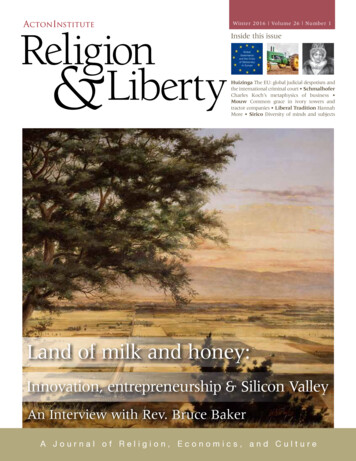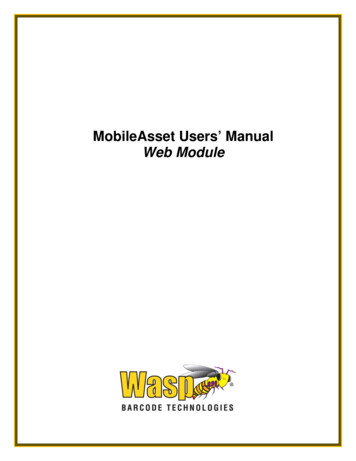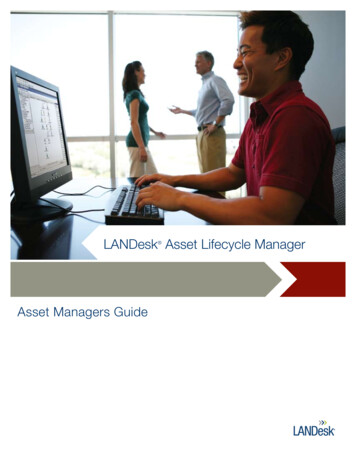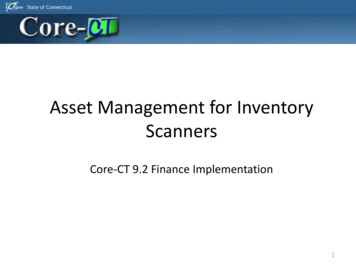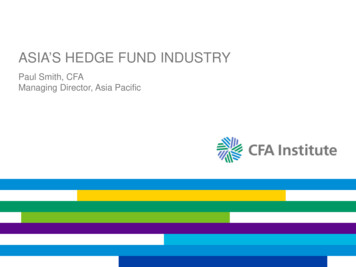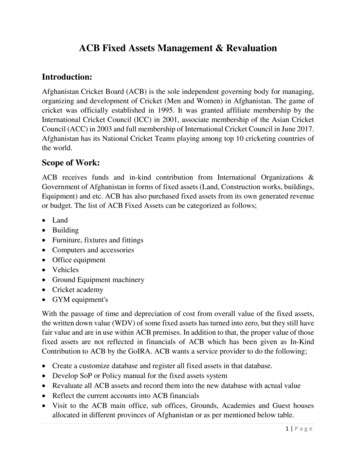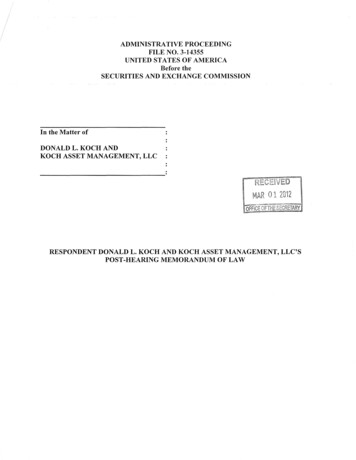
Transcription
ADMINISTRATIVE PROCEEDINGFILE NO. 3-14355UNITED STATES OF AMERICABefore theSECURITIES AND EXCHANGE COMMISSIONIn the Matter ofDONALD L. KOCH ANDKOCH ASSET MANAGEMENT, LLC01RESPONDENT DONALD L. KOCH AND KOCH ASSET MANAGEMENT, LLC'SPOST-HEARING MEMORANDUM OF LAW
TABLE OF CONTENTS1INTRODUCTIONBACKGROUND . 2I.A.B.C. 4MR. KOCH AND KAMDecember 31, 2009 Purchase of CARY . 8December 31, 2009 Purchase of CHEV . 11Purchases ofHCBC in the fourth quarter of2009 . .151.September 30, 2009 Purchase of HCBC . .172.The October 30,2009 Purchase ofHCBC . .213.November 30,2009 Purchase ofHCBC . 234.December 31,2009 Purchase ofHCBC . .24II.RESPONDENTS PRODUCED ALL AVAILABLE DOCUMENTS . 27III.KAM HAD ADEQUATE PROCEDURES . 28ARGUMENT . 29I.EXCHANGE ACT SECTION I O(B) AND ADVISERS ACT SECTION 206ALLEGATIONS . 29A.Respondents Did Not Manipulate the Market . 331.The Division Has Not Established the Requisite Scienter . 342.Alleged Intent Coupled With Lawful Activity Should Not Support MarketManipulation Allegations . .413.Respondents Had a Legitimate Purpose For Their Trades . .43II.ACTRESPONDENTS' BOOKS AND RECORDS COMPLIED WITH THE ADVISERS44RESPONDENTS' POLICIES AND PROCEDURES COMPLIED WITH THEIII.ADVISERS ACT . 47CONCLUSION . 49-1-
TABLE OF AUTHORITIESPage(s)CASESAaron v. SEC,446 U.S. 680, 100 S.Ct. 1945,64 L.Ed.2d 611 (1980) . 29ECA, Local 134 IBEW Jt. Pension Trust of Chicago v. JP Morgan Chase Co.,533 F.3d 187 (2d Cir. 2009) . 30GFL Adv. Fund, Ltd v. Colkitt,272 F.3d 189 (2001) . 30, 31In re Amaranth Nat. Gas Commodities Litig., L.L. C.,587 F. Supp. 2d 513 (S.D.N.Y. 2008) . 29In re Centerline Holding Co. Securities Litig.,380 Fed. Appx. 91 (2d Cir. 2010). 29In re Pfizer Securities Litig.,584 F. Supp. 2d 621 (S.D.N.Y. 2008) . 32In the Matter of Graham,Release No. 40727, 1997 WL 530040 (Nov. 30, 1998)Kurz v. Fidelity Mgmt. & Rsch. Co.,556 F.3d 639 (7th Cir. 2009). 28. 33Markowski v. SEC,274 F.3d 525 (2001) . 31, 32Santa Fe Industries, Inc. v. Green,430 U.S. 462,97 S.Ct. 1292,51 L.Ed.2d 480 (1977) . 28SEC v. Capital Gains,375U.S.l80(1963). 28SEC v. Czarnik,2010 WL 4860678 (S.D.N.Y. Nov. 29, 2010). 29, 30SEC v. Gotchey,11992 WL 385284 (4 h Cir. Dec. 28, 1992) . .29SEC v. Masri,523 F. Supp. 2d 361 (S.D.N.Y. 2007) . 33, 42-11-
SEC v. Perez,2011 WL 5597331 (S.D. Fla. Nov. 17, 2011) . .Superintendent of Ins. ofState of NY v. Bankers Life & Cas. Co.,404 U.S. 6, 92 S.Ct. 165,30 L.Ed.2d 128 (1971). 49. 28STATUTES AND RULESRule 204-2(a)(7) . .2, 44, 46, 49Rule 206(4)-747,49Section 1O(b) of the Securities and Exchange Act of 1934passimSection 206 of the Investment Advisers Act of 1940 . .passimSections 15(b) and 21 C of the Securities Exchange Act of 1934 . 32-111-
INTRODUCTIONIn this action is no self-dealing or profit to Donald Koch or KAM. There is no motive forsecurities fraud. There is no injury to the clients. There is no injury to the markets and thepublic. The building blocks of market manipulation - artificial prices, self-dealing at theexpense of clients and injury to market and the public- are missing.What is present in this case is largely undisputed evidence that: KAM and Donald Koch have faithfully served their clients and friends for years; That KAM and Donald Koch have successfully implemented an investmentprogram grounded in experience and the academic economic literature; The program yielded very good returns -some might say extraordinary returns-for clients as reflected the profits made by Mrs. Smith, Tampsco, Jim Ewoldt,Don Cyril and others; Testimony from a former SEC Chief Economist that the trading techniques usedhere to acquire shares of High Country, Carver Financial and Cheviot whichinclude transactions at the end of the day and priced at or over the bid were notonly appropriate but required to purchase these securities in these markets; Testimony from a former SEC Chief Economist that there is no evidence ofmarking the close in the transactions where KAM purchased shares of CarverFinancial and Cheviot; Testimony from a former SEC Chief Economist establishing that the purchases ofHigh Country securities were at prices consist with those of other transactions inthe stock before and after; Testimony from a KPMG partner that each of the security purchases here was inaccord with KAM's long standing investment program; and Profitable investments for Mrs. Smith and Tampsco.The record here is also repeat with misunderstandings and allegations built on snippets oftransactions and fragments of tapes- the building blocks of the OIP and the Division' claims: A marking the close charge built on claims centered on trading at the end of the day andperiod, purchasing at prices at or over the bid and setting the closing price. Yet it is
undisputed that in these markets the only way to acquire blocks of stock is to utilize thesetechniques as experienced traders know; A best execution claim that is built on the supposition that each purchase here was madeat or above the bid to push up the price. Yet the undisputed evidence demonstrates that inthese markets it is a common and often necessary trading tactic to pay at or over the bidto acquire blocks of securities as KAM did; A failure to maintain records claim based on not producing one e-mail which was part ofa chain and an unsupported claim about redaction. Yet the undisputed evidence from aKPMG partner is that KAM had excellent record keeping systems and that forensictesting established every relevant record was produced - there was no redaction; A failure to implement procedures charge which ignores KAM's meticulous code ofconduct, appointment of a chief compliance officer and the fact that its actions werecarefully monitored in the best and only way possible for a sole proprietorship- bykeeping clients fully informed of each transaction so they could monitor thereinvestments.In the end the only injury here is to clients who have been deprived of the services of agood and faithful investment advisor who has made them extraordinary profits over the years. Inthe end the only injury is to an investment advisor and his firm which has been deprived of theopportunity to continue serving his clients and friends.Now is the time to end the misunderstandings and misperceptions on which this case hasbeen built. Now is the time to dismiss the OIP and all of the charges against Donald Koch andKAM.BACKGROUNDOn April25, 2011 the Securities and Exchange Commission issued an Order InstitutingAdministrative and Cease-and-Desist Proceedings (the "OIP") naming as Respondents Mr. Kochand KAM. Mr. Koch and KAM responded to the OIP on May 20,2011. In the OIP, theDivision of Enforcement made three key allegations which Respondents deny:First, the Division alleges that on four days in 2009, Mr. Koch and KAM instructed atrader at Huntleigh Securities Corporation ("Huntleigh") to execute trades at the end of the-2-
trading day in an attempt to mark the close in violation of Section 1O(b) of the Exchange Act andRule 1Ob-5 thereunder and Sections 206(1) and 206(2) of the Advisers Act. OIP, 26-27.According to the OIP the Huntleigh trader bought 1,400 1 shares of High Country BankCorporation ("HCBC") on September 30, 2009, 600 shares ofHCBC on October 30, 2009, 2,000shares ofHCBC on November 30,2009, and 3,200 shares ofHCBC on December 31,2009.OIP, 7, 10, 13, 16. The OIP also alleges that the trader acquired 6,000 2 shares of CheviotFinancial Corporation ("CHEV") and 200 shares of Carver Ban corp, Incorporated ("CARV") onDecember 31, 2009. 0 IP, 18-19. The motive, according to the Division, was to "artificiallyimprove the reported monthly performance for each account holding that security." OIP, 6. Asa corollary to this claim, the Division alleges that Respondents did not seek best execution on thetrades. OIP, 21.Second, the Division alleges that KAM violated Section 204 of the Advisers Act andRule 204-2(a)(7) thereunder by failing to adequately maintain certain books and records, and thatMr. Koch aided and abetted that violation. OIP, 29. Third, the Division alleges that KAMviolated Section 206(4) of the Advisers Act and Rule 206(4)-7 thereunder by failing toimplement written policies and procedures reasonably designed to prevent violation of theAdvisers Act, and that Mr. Koch aided and abetted such violations. OIP, 28.A hearing was held in this matter from January 10,2012 through January 13,2012, onJanuary 17, 2012, and on January 20, 2012. 3 Three fact witnesses testified on behalf of theThe OIP incorrectly states that KAM acquired I,400 shares ofHCBC on September 30,2009. OIP, 7. KAMin fact acquired 2,000 shares ofHCBC on September 30, 2009. Exh. R039 at 4 I.23The OIP incorrectly states that KAM acquired 6,000 shares of CHEV on December 3 I, 2009. OIP,in fact acquired 6,667 shares of CHEVon December 3 I, 2009. Exh. R039 at 28. I 8. KAMFollowing the conclusion of the testimony in this matter, the Division marked seven new exhibits proposedexhibits 340-346 and offered them for admission into evidence. In an effort to avoid a dispute over theseexhibits, Respondents attempted to negotiate a compromise on the question, to no avail. Respondents therefore-3-
Division: Catherine Marshall, Eli Straeter, and Jeffrey Christanell. One summary witness,Stephen Glascoe, testified on behalf of the Division. Four fact witnesses testified on behalf ofRespondents: Donald Cayce, James Ewoldt, Faith Heidtbrink, and Donald Koch. Two expertwitnesses, John Schneider ofKPMG and Professor Gregory Jarrell, testified on behalf ofRespondents.Many of the facts surrounding this matter remain largely undisputed.I.Mr. Koch and KAMMr. Koch is the founder and president ofKAM. Tr. at 786-87 (Koch). Prior to foundingKAM, Mr. Koch had an extensive background in economics and commercial banking. Tr. at 766(Koch). In particular, he worked for nine years at the Barnett Banks of Florida ("Barnett") asChief Economist and Strategic Planner and then for five years as Senior Vice President, Directorof Research at the Federal Reserve Bank of Atlanta. Tr. at 766-68, 780 (Koch).During his tenure at Barnett, Mr. Koch evaluated smaller banks for potential acquisitionby Barnett, and made recommendations regarding those banks. Tr. at 767-75 (Koch). In doingso, Mr. Koch devised a particular strategy for evaluating a bank's value and later began investingon his own behalf using the principles he had developed at Barnett. Tr. at 784 (Koch).Essentially, Mr. Koch had learned through his experience that community banks wereundervalued properties that, eventually, would be bought by larger banks. Tr. at 784-86 (Koch).In determining if a particular bank is a good investment Mr. Koch begins with an examination ofthe demographics of the bank's region, to determine whether it was an area to which people arelikely to move, and, by extension, need banks. Tr. at 828 (Koch). After he's assesses theobject to the admission of these materials which, from examining their content, appear to be little more than aneffort to contradict portions of testimony without giving the relevant witnesses an opportunity to respond andwithout giving Respondents the opportunity to conduct redirect. The admission of these exhibits would beunfair, particularly at this late date when briefing is nearly complete.-4-
geographic possibilities of a region, Mr. Koch then researches the bank itself: its management;its officers and directors; its branches; and its financial information. Tr. at 834-35 (Koch).Using all of that information, he determines the bank's book value, adjusted to take into accountassets and liabilities Mr. Koch believed were not accounted for in traditional book valuecalculations. The result is a figure he calls the bank's tangible book value, or TBV.Once Mr. Koch ascertains that a bank is a good investment, KAM purchases and holdsthe stock for the long term, typically 5 to 10 years. Tr. at 884 (Koch); Tr. at 1089-90 (Jan-ell).His method has proven very successful. Tr. at 786 (Koch).Mr. Koch never had any desire to have clients or become an investment advisor. Tr. at786 (Koch). He initially invested only on his own behalf, but eventually his friends andacquaintances began asking him to manage their funds as well. Tr. at 788 (Koch). Mr. Kochwas reluctant to manage money for other people because he understood it to be a greatresponsibility and wanted to make sure his investment philosophy worked and would not losemoney. Tr. at 788-89 (Koch). He believed that when a client gave him money to manage, it washis responsibility to do no harm, and he ran KAM, which he opened to serve his clients, with thatphilosophy. Tr. at 786-87, 819 (Koch).When he began KAM, Mr. Koch hired a lawyer to draft an investment advisoragreement. 4 Tr. at 797 (Koch); Exh. R006. The investment advisor agreement set forth KAM'sinvestment strategy:Advisor shall provide advice and discretionary management services to Ownerregarding the investment of securities by Owner. Advisor shall provide advice4KAM also adopted a written policies and procedures manual in 2008. Tr. at 812 (Koch); Exh. 279. Thepolicies and procedures manual contained provisions regarding KAM's core principles, its code of ethics, andits promise to seek best execution for client trades. Tr. at 813-19 (Koch); Exh. 279 at 3, 5-11, SEC-KOCH7156. The KAM policies and procedures manual was available to any client, or anyone at all, who wanted toreview it. Tr. at 686 (Heidtbrink).-5-
and discretionary management services to Owner regarding the initial investmentand reinvestment of such securities from time to time in accordance with theinvestment objective of Owner which is to invest in securities (primarily publiclytraded) of financial institutions which generally have assets of at least 100million and which are perceived to be undervalued based upon the value of theinstitution's assets and the quality of the institution's management.Exh. R006, 1; Exh. R036 at 4.Mr. Koch also repeatedly explained KAM's investment philosophy and objectives to hisclients. Exh. R006, 1; Tr. at 798 (Koch). Prior to a client signing the investment advisoragreement, Mr. Koch met with the client as many as five times in order to make sure the clientunderstood that KAM would direct investment only in small financial institutions. Tr. at 798(Koch). He also explained how he arrived at a company's tangible book value, and that hebought stock at below tangible book value. Tr. at 798 (Koch).Throughout KAM's entire nearly 20-year history, it always directed trading on behalf ofits clients based on a consistent investment philosophy, which had grown out of Mr. Koch'sexperience in the commercial banking industry. Tr. at 825-26 (Koch). Mr. Koch and KAM'sclients generally received excellent returns, thanks to KAM's stated policy of investing in smallfinancial institutions. Tr. At 944 (Schneider) (referring to the three stocks at issue here, HCBC,CHEV and CARV).In particular, the accounts cited in the OIP had excellent returns. Alice and Philip Smith,Mr. Koch's original clients, invested approximately 127,000 over time with KAM. Tr. At 806(Koch). By the time Mrs. Smith passed away in 2010 (her husband died in 2005) their combinedaccounts were worth approximately 1.5 million after having withdrawn approximately 533,000. Tr. at 802, 806 (Koch). Tampsco, the other account implicated by the OIP, was aninvestment vehicle for a large family in St. Louis. Tr. At 807-08 (Koch). Tampsco's returnswere even better than the Smiths'. Tr. at 807-08 (Koch).-6-
Many ofKAM's accounts, including the Smiths' accounts and the Tampsco account,were custodianed at Huntleigh Securities Corporation ("Huntleigh"). Mr. Koch generallyinstructed Huntleigh traders, including Mr. Christanell, to seek the particular stocks he wanted attheir discretion, but with a purchase limit price of Mr. Koch's calculated tangible book value.Tr. at 879-80 (Koch); Tr. at 551-52 (Christanell). Even so, Mr. Christanell did not understandMr. Koch's investment philosophy or why Mr. Koch traded the way he did; Mr. Christanellsimply knew what stocks Mr. Koch wanted and what his limits were. Tr. at 902-03 (Koch).II.KAM's Purchases in CARV, CHEV and HCBCKAM purchased 2,000 5 shares ofHCBC on September 30,2009, 600 shares ofHCBC onOctober 30, 2009,2,000 shares ofHCBC on November 30,2009, and 3,200 shares ofHCBC onDecember 31, 2009. On December 31, 2009 KAM purchased 6,667 6 shares of CHEV and 200shares ofCARV. OIP, 7, 10, 13, 16, 18-19. The OIP alleges that each purchase was made atan artificial, manipulated price which did not reflect best execution and that in each instanceKAM set the closing price and "marked the close" as part of an effort to "artificially improve thereported monthly performance for each account . "on the monthly brokerage statement eachKAM client received from their respective brokerage firm. OIP, 5-6,21.The Division's allegations are not supported by the proof it offered at the hearing and therecord. To the contrary, the largely undisputed evidence in the record contradicts the Division'sallegations. Not only did the Division fail to establish an artificial price, but also the evidencedemonstrates that the prices KAM paid for the stocks it purchased were in keeping with the56Again, the OIP incorrectly states that KAM acquired l ,400 shares of HCBC on September 30, 2009. KAM infact acquired 2,000 shares of HCBC on September 30, 2009. Exh. R039 at 41.The OIP incoJTectly states that KAM acquired 6,000 shares ofCHEV on December 31,2009. OIP,in fact acquired 6,667 shares ofCHEV on December 31,2009. Exh. R039 at 28.-7- 18. KAM
market. Likewise, not only did the Division fail to establish any benefit to Mr. Koch or KAMbut, to the contrary, the evidence demonstrates that such actions would be completely contrary tothe long-term investment program that had been so successful for KAM's clients over the years.A.December 31, 2009 Purchase of CARVCarver Bancorp, Inc. is a community bank based in Harlem, New York, with more than 800 million in assets Tr. at 850 (Koch). Using his TBV analysis Mr. Koch believed Carver tobe an excellent takeover target, and has been directing investment in Carver, with the tickersymbol CARY, since the late 1990s. Tr. at 850, 852 (Koch). Based on Mr. Koch's assessmentin 2009, Carver's stock had a TBV in excess of 20 per share. 7 Tr. at 854 (Koch). This meantthat KAM wanted to acquire shares at an average cost of no more than 20 per share but at alower price when market conditions permitted. Tr. at 842-43, 859 (Koch).As of December 2009, Carver stock was one of the most illiquid held by KAM clients; ithad a bid-ask spread of 12.8% in 2009, indicative of high illiquidity. Exh. R039 at 23-24; Tr. at1056-57, 1059, 1080 (Jarrell). That meant that a potential purchaser would have to search forliquidity, that is, a time when the security is available and can be purchased. Tr. at 1083-85(Jarrell).On December 31, 2009 KAM purchased 200 shares of Carver at an average price of 9.0475 per share which was slightly below the closing price of 9.05 for the day. Exh. 278 at 3.Thus the price paid was almost 11 below tangible book value, making the purchase a veryfavorable transaction in the context ofKAM's investment program. Tr. at 821 (Koch).7By the end of 20 I 0 Mr. Koch altered his analysis of Carver Financial due to non-performing assets the bank hadacquired and KAM liquidated the positions of its clients in the security. Tr. at 852-853 (Koch).-8-
The purchase was made for KAM by Mr. Christanell. On December 31, 2009 at13:01 :32 (1 :32 p.m.), 8 Mr. Christanell entered a limit order in Huntleigh' s system for 1,000shares of CARY with a limit price of 9.05. Tr. at 1100 (Jarrell); Exh. 278 at 3. Mr. Koch didnot email Mr. Christanell to purchase 1,000 shares of CARY, nor is there an audio tapedconversation in which Mr. Koch or anyone directed Mr. Christanell to put in a limit order at 9.05 for 1,000 shares.The only reference to CARY prior to the entry of the order came during a conversationwhich, according to Exhibit 191, took place at 12:41 p.m. 9 In that conversation Mr. Christanellnotes that the spread for CARV is 8.10 to 9.05 and that there have not been any trades thatday: "No trades. No volume . " but there are 2,000 shares offered at 9.05. Mr. Kochauthorized the purchase of Carver shares, responding "so what you do at the end of the day, popthat one . ,"to which Mr. Christanell responds "Yeah, five." Exh. 191.That conversation contains no reference to the quantity or the limit order price. Mr.Christanell's statement of "5" may mean 5,000 shares, although it is not clear. Accordingly,either there were other conversations not reflected on the tape since Huntleigh policy required allorders to be oral (Tr. at 170 (Marshall)), or Mr. Christanell utilized his discretion and actedwithin the general parameters that Mr. Koch typically authorized, that is, trying to purchase a89Times listed in the text are those on the exhibit. For ease of reference the parenthetical following the referenceis the time stated in Eastern Standard Time (or, where applicable, in Eastern Daylight Time).In addition to the other questions regarding the reliability of the tapes (Tr. at 10 1-07), the evidence clearlyestablishes that the time for at least one conversation is incorrect. Division Exhibit 192 is represented to havetaken place at 3:48p.m. EST, a few minutes prior to the 4:00p.m. close of the market. Yet in the text of theconversation Mr. Christanell states that the market is closed. This demonstrates that the time on the tape for atleast this conversation fi·agment is wrong and off by more than 12 minutes. Whether the times represented onthe other tapes are accurate cannot be determined by comparison of the content to the time extracted from theHuntleigh system. Since all of the times came from the same screen shot (Exh. 319) the available evidencesuggests that either the computer generating the times deviated for unexplained reasons for one conversation butnot others, or the times for other fragments and perhaps all are inaccurate. There also is no evidence in therecord that they were not altered or modified in some way.-9-
block of at least 1,000 to 2,000 shares with a limit order capping the price that would be paidbelow TBV but at an amount which will create the best chance to acquire the stock as Mr. Kochtestified (Tr. at 879-80 (Koch); Tr. at 551-52 (Christanell)).In this instance entering a limit order at 9.05 for 1,000 shares gave KAM theopportunity to purchase the stock at a price lower than the existing bid in the market since anyexecution would be at the best available price up to that bid. Tr. at 1100-02 (Jan-ell). Waitinguntil the close of the market to buy the shares maximized the opportunity for KAM to purchasethe shares at a lower price because other traders might appear toward the close since that ittypically when the markets are most liquid. Tr. at 1065 (Jan-ell); R039 at 14-15. It also ensuredthat the stock would be acquired since there was an offer of2,000 shares at 9.05 in the market.Exh. 191.Subsequently, Messrs. Christanell and Koch briefly discussed purchasing shares ofCARY at what appears to be 3:09p.m., when Mr. Christanell states that he is thinking of"justbuying like 300 shares at 9.05" at the end of the trading day. Mr. Koch agreed. Exh. 190. 10 The1,000 share 9.05 limit order was not modified. Exh. 278.Mr. Christanell routed an order for 200 shares ofCARV to the market at 15:58:36(3:58:36 p.m.) or less than two minutes before the market close. The order was filled in two10Jn this conversation Mr. Koch tells Mr. Christanell to "get a print." The Division argues the phrase refers toestablishing a closing price. Division Br., I 04. This interpretation hinges on the theory that Mr. Koch wasonly interested in establishing a closing price, not acquiring the stock. If that were true, and in view of theDivision's theory regarding the reasons for marking the close, there would be no need to purchase any stocksince at the point of the conversation no trades had taken place and under Huntleigh's procedures a closing pricefor statement purposes could have been established by entering a bid at the desired price at the close of themarket. Ex h. 191 (tape of conversations). [The odd lot transaction involving 3 shares at the market openingwould not establish the closing price (see Exh. R039 at 36 )]. This contention is at odds with the fact that Mr.Koch expressed disappointment at the end of the day with the number of shares purchased. Exh. 192.Accordingly, a more plausible reading is that it refers to displaying a price- print- on the trading tape so that itattracts market attention and the opportunity to purchase the stock if possible. This is consistent with Mr.Koch's repeated statements that he wanted to acquire the difficult to purchase stock and hold it. Tr. 819, 890,924 (Koch). It is also consistent with the fact that on December 3 I, as well as on the other dates at issue in thiscase, KAM purchased and held significant blocks of securities.-10-
pmis, one execution of 100 shares for 9.045 at 15:58:37 (3:58p.m.) and a second execution of100 shares for 9.05 at the same time. Exh. 278 at 3; Tr. at 1101-02 (Jarrell); Exh. R039 at 36.The executions were at the then best available prices under the 9.05 limit price, ensuring thatKAM's purchases received best execution. Tr. at 591 (Christanell).In the end, the purchases were at the low price of the day of 9.045 and the bid price of 9.05. Tr. at 959-60 (Schneider). The average price paid by KAM for the 200 shm·es is 9.0475,slightly below the high price of the day. Exh. 278 at 3. Based on the executions it is apparentthat another seller appeared in the market shortly before the close. Thus KAM's trading tacticsecured a slight savings in price while acquiring the stock.The closing price for CARV on December 31, 2009 was set by a trade for 200 shares at 9.05 at 16:00:03 (4:00:03 p.m.) just seconds after the close by a non-KAM market participant.Exh. R036 at 36; Tr. at 1102 (Jarrell). Again, it is clear that other buyers waited until the close topurchase shares.B.December 31, 2009 Purchase of CHEVCheviot Financial Corporation, ticker symbol CHEV, is a small community bank aroundCincinnati that Mr. Koch has invested about ten years, similar to Carver. Tr. at 844, 846-47(Koch).Before investing in CHEV, as with all of his investments, Mr. Koch visited branches,took pictures, reviewed all of its financial information and met the management. Tr. at 845-48(Koch); RO 18. He continues to periodically review and analyze its financial statements and talk-11-
with its management to ensure that it continues to be a good long-term investment for KAMclients. Tr. at 848-49 (Koch).Mr. Koch calculated the tangible book value for CHEV shares to be about 12 to 15 pershare. Accordingly KAM's investment program specified that the average share price for thebank stock had to be at or below that price range. Tr. at 798 (Koch).CHEVis one of the most illiquid stocks held by KAM clients. Exh. R039 at 24. It has abid-ask spread of 4.9% compared to the average NASDAQ stock which has a spread of0.24%.R 39 at 23-24. In 2009 it did not trade on over 10% of the business days when the market wasopen. Exh. R039 at 25.The ill
Tr. at 784 (Koch). Essentially, Mr. Koch had learned through his experience that community banks were undervalued properties that, eventually, would be bought by larger banks. Tr. at 784-86 (Koch). In determining if a pa




